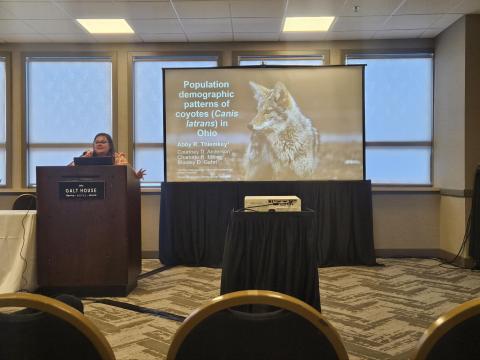Here, There, and Everywhere
The project is now entering its fourth year of operation, and we are starting to analyze the data that we have been collecting. Project members Abby Thiemkey and Courtney Anderson have been busy sharing some preliminary results with the Ohio public and other wildlife researchers at conferences at the local, national, and international levels.
In July of last year, both Abby and Courtney presented at the joint International Mammalogical Congress and American Society of Mammologists Conference in Anchorage, AK. Both presentations were about our work on diet analysis through stable isotopes. Abby talked about how coyote diets differ in different parts of the state, while Courtney talked about how individual coyotes appear to be specializing in different foods.
In November, project members attended The Wildlife Society conference in Louisville, KY. Abby gave a presentation for a national audience on population demographics of Ohio's coyotes, sharing that we've found that Ohio's coyote population is very young, with a huge proportion of them being less than a year old. This is an important step toward our goal of understanding population dynamics for better management.
Abby also gave a presentation to Extension educators at The Ohio University's Pesticide Safety Education Inservice in December, sharing tips on how to avoid conflict with coyotes. This is one of the main goals of the project: helping understand and reduce conflict with coyotes, particularly for livestock producers.
Most recently, in January, Courtney presented at the Ohio Wildlife Management Conference in Columbus, OH. This conference is a local platform for wildlife managers from around the state to talk about current issues and new research. Courtney shared some more of our results on individual specialization in coyote diets and how difficult it is to describe the diet of a "typical coyote." This is important to keep in mind when we consider management of a species due to its perceived impacts on other species.
Our team just can't stop talking about coyotes!

